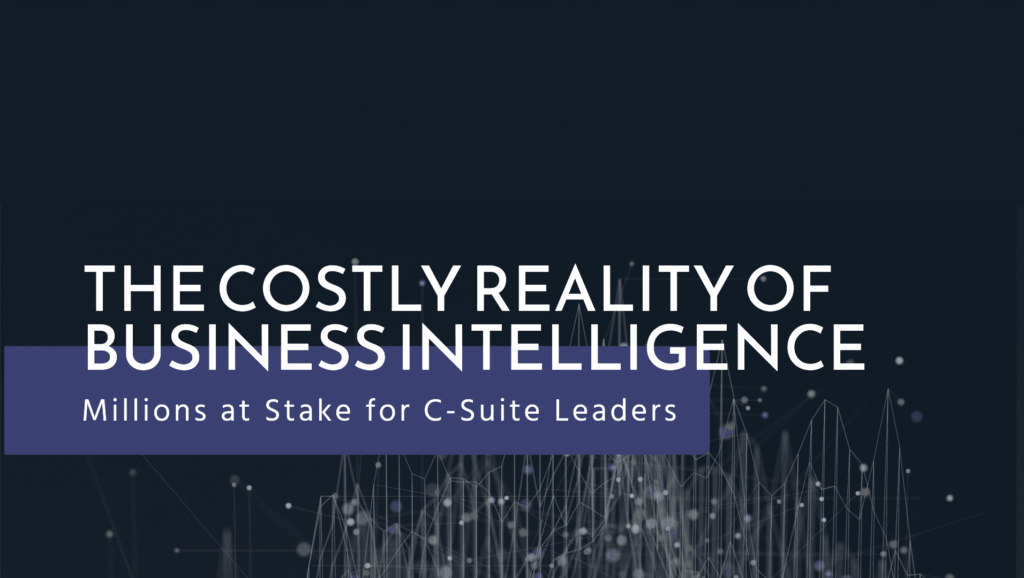As competition sharpens across industries, data has evolved from a mere resource to a crucial advantage. Companies that excel in data analytics are positioning themselves as leaders, driving innovation and growth. Meanwhile, those that lag behind face the risk of being outperformed by more data-savvy competitors. The ability to make swift, confident decisions powered by quality data and actionable business intelligence (BI) is no longer a luxury—it’s a necessity.
However, the journey to becoming a data-driven organization is fraught with challenges. High costs, complex integrations, and the need for specialized talent make it difficult for companies to achieve the value they expect and need from their data investments. Companies risk becoming distracted by data initiatives, losing sight of their core business objectives, sinking millions into efforts that may not deliver the anticipated return on investment (ROI).
Savvy business leaders need to find ways to acquire the benefits of data, KPI visibility, and insights, without letting the costs outweigh those gains.
The Benefits of Data are Clear
At risk of stating the obvious – data and analytics are core needs for any business looking to succeed. In fact, according to McKinsey & Company data-driven organizations are 23 times more likely to acquire customers, six times more likely to retain them, and 19 times more likely to be profitable. Being a data-driven organization offers several key benefits, particularly when it comes to visibility into KPIs:
- Informed Decisions: Leaders of data-driven organizations can make precise decisions based on real-time insights, reducing uncertainty and enhancing strategic planning.
- Proactive Problem-Solving: Continuous visibility enables early identification of issues, allowing for timely interventions and risk mitigation.
- Performance Tracking: Accurate tracking of performance ensures that all teams align with business objectives, boosting efficiency and productivity.
- Efficient Resource Allocation: Clear insights into KPIs guide the effective allocation of resources, maximizing returns.
- Agility: Real-time data allows for quick adaptation to changing conditions, keeping the organization competitive and responsive.
- Accountability: Transparent metrics foster a culture of accountability, driving teams to meet targets and improve continuously.
This should come as no surprise as according to a HBR report, 97% of leaders believe that democratizing data and analytics across the organization is important for business success. The potential value that data can bring to an organization is significant. However, this value is often undermined by the complexities and inefficiencies inherent in data management.
The Balance Between Cost and Value
The investment in data science should be seen not only as a cost center but as a strategic asset that can drive significant business value. However, the challenge lies in ensuring that the value derived from data outweighs the costs associated with it. This balance between cost and value is crucial for companies, particularly as they scale.
Data is the new oil, but just like oil, its value is only realized when it is refined and processed correctly. Data-driven insights can lead to better decision-making, improved operational efficiency, and enhanced customer experiences. However, achieving these outcomes requires a significant investment in people, processes, and technology. The risk is that without proper management, these investments can spiral out of control, leading to high costs with little return. Let’s look at the main drivers of these costs: data headcount and infrastructure.
The High Cost of Data Experts
One of the most significant costs associated with building a data-driven organization is the need for a robust data science team. The demand for data scientists, analysts, and engineers has surged in recent years, driven by the increasing complexity of data management and analysis. According to the Bureau of Labor Statistics, employment of data scientists is projected to grow by 31% from 2019 to 2029—much faster than the average for all occupations.
This high demand translates into substantial salary costs. Here are the average salaries for various data science roles in 2024:
| Data Science Role | Average Salary (2024) |
| Junior Data Scientist | $130,000 |
| Mid-level Data Scientist | $157,000 |
| Senior Data Scientist | $185,000 |
| AI Model Developer | $150,000 |
| Python Developer | $140,000 |
| ETL Developer | $130,000 |
| Data Engineer | $150,000 |
| Data Analyst | $120,000 |
| BI Developer | $135,000 |
| Business Analyst | $115,000 |
This table illustrates the average salaries for various data science roles in 2024.
For companies in the growth stages, such as Series B, C, and D, these costs can quickly escalate:
Series B
| Data Science Role | Average Salary (2024) | Number of Data Employees (Of Avg. 75 Total Employees) | Estimated Annual Cost |
| Junior Data Scientist | $130,000 | 2 | $260,000 |
| Mid-level Data Scientist | $157,000 | 4 | $628,000 |
| Senior Data Scientist | $185,000 | 2 | $370,000 |
| AI Model Developer | $150,000 | 3 | $450,000 |
| Python Developer | $140,000 | 3 | $420,000 |
| ETL Developer | $130,000 | 3 | $390,000 |
| Data Engineer | $150,000 | 4 | $600,000 |
| Data Analyst | $120,000 | 4 | $480,000 |
| BI Developer | $135,000 | 3 | $405,000 |
| Business Analyst | $115,000 | 4 | $460,000 |
| Total Annual Cost | $4,463,000 | ||
| Two-Year Cost | $8,926,000 | ||
| Four-Year Cost | $17,852,000 |
This table illustrates the estimated annual cost of a data science team of a Series B company.
Series C
| Data Science Role | Average Salary (2024) | Number of Data Employees (Of Avg. 150 Total Employees) | Estimated Annual Cost |
| Junior Data Scientist | $130,000 | 4 | $520,000 |
| Mid-level Data Scientist | $157,000 | 8 | $1,256,000 |
| Senior Data Scientist | $185,000 | 3 | $555,000 |
| AI Model Developer | $150,000 | 6 | $900,000 |
| Python Developer | $140,000 | 5 | $700,000 |
| ETL Developer | $130,000 | 4 | $520,000 |
| Data Engineer | $150,000 | 8 | $1,200,000 |
| Data Analyst | $120,000 | 6 | $720,000 |
| BI Developer | $135,000 | 5 | $675,000 |
| Business Analyst | $115,000 | 5 | $575,000 |
| Total Annual Cost | $7,621,000 | ||
| Two-Year Cost | $15,242,000 | ||
| Four-Year Cost | $30,484,000 |
This table illustrates the estimated annual cost of a data science team of a Series C company.
Series D
| Data Science Role | Average Salary (2024) | Number of Data Employees (Of Avg. 350 Total Employees) | Estimated Annual Cost |
| Junior Data Scientist | $130,000 | 8 | $1,040,000 |
| Mid-level Data Scientist | $157,000 | 12 | $1,884,000 |
| Senior Data Scientist | $185,000 | 5 | $925,000 |
| AI Model Developer | $150,000 | 10 | $1,500,000 |
| Python Developer | $140,000 | 8 | $1,120,000 |
| ETL Developer | $130,000 | 6 | $780,000 |
| Data Engineer | $150,000 | 12 | $1,800,000 |
| Data Analyst | $120,000 | 10 | $1,200,000 |
| BI Developer | $135,000 | 8 | $1,080,000 |
| Business Analyst | $115,000 | 7 | $805,000 |
| Total Annual Cost | $12,134,000 | ||
| Two-Year Cost | $24,268,000 | ||
| Four-Year Cost | $48,536,000 |
This table illustrates the estimated annual cost of a data science team of a Series D company.
Data Infrastructure and Tooling Costs
In addition to personnel costs, companies must also invest in the necessary infrastructure and tools to support their data initiatives. These costs can add up quickly, especially as the organization scales.
Estimated data storage and processing costs include Databricks at $37,000 annually and AWS S3 at $13,800 annually. Compute costs, such as AWS EC2, can amount to $60,000 annually. ETL tools like Fivetran and Talend cost $18,000 and $11,700 annually, respectively. Business intelligence tools like Tableau and Power BI add another $84,000 and $24,000 annually. Additional infrastructure expenses include servers at $50,000, networking and security at $20,000, and data centers at $30,000 annually.
Data Infrastructure and Tooling Costs:
| Category | Item | Details | Estimated Annual Cost |
| Data Storage and Processing | Databricks | Typical contract value | $37,000 |
| Cloud Services | AWS S3 | $0.023 per GB per month, 50 TB | $13,800 |
| AWS EC2 | $1,000 per month per instance, 5 instances | $60,000 | |
| ETL Tools | Fivetran | $1,500 per month | $18,000 |
| Talend | $1,170 per user per year, 10 users | $11,700 | |
| Business Intelligence (BI) Tools | Tableau | $70 per user per month, 100 users | $84,000 |
| Power BI | $20 per user per month, 100 users | $24,000 | |
| Hardware and Infrastructure | Servers | 5 servers at $5,000 – $10,000 each | $50,000 |
| Networking and Security | Networking equipment, firewalls, and security tools | $20,000 | |
| Data Centers | Co-location costs, power, cooling (annual) | $30,000 | |
| Total Annual Cost | $348,500 | ||
| Two-Year Cost | $697,000 | ||
| Four-Year Cost | $1,394,000 |
This table illustrates the estimated annual cost of data infrastructure and tool licensing.
These figures highlight the significant financial commitment required for maintaining data infrastructure and tool licenses.
The Pitfalls of Traditional Data Approaches
Many companies, in their efforts to become data-driven, fall into the trap of investing heavily in multiple data tools and platforms without a clear strategy for integration. This leads to data silos, where information is isolated in different systems, making it difficult to gain a comprehensive view of the business. Additionally, the reliance on manual processes for data integration and analysis increases the risk of human error, further diminishing the value of the data.
Case Study: Zendesk (Series C) – Sales Optimization: Zendesk invested heavily in integrating data sources to optimize their sales processes but faced significant hidden costs for maintaining and updating these systems.
Case Study: HubSpot (Series D) – Marketing Enhancement: HubSpot employed data science for budget optimization, campaign management, and personalization. They found that marketing data efforts were far more expensive than anticipated, primarily due to the continuous need for data cleaning and integration.
Case Study: ServiceNow (Series C) – Customer Service Improvement: ServiceNow used predictive analytics to enhance customer service by identifying at-risk customers and recommending retention strategies. They underestimated the costs of managing and analyzing customer data, leading to substantial ongoing expenses.
Case Study: Slack (Series B) – Product Development: Slack depended on data analytics for developing data-driven product features. They encountered rising costs from data collection, storage, and integration issues, which delayed product enhancements and increased expenses.
Case Study: Stripe (Series C) – Risk and Financial Management: Stripe applied data science for risk assessment, financial forecasting, and operational efficiencies. They faced unexpected costs related to data integration and regulatory compliance, straining their financial resources.
Commitment Over Time: Financial Impact
Understanding the long-term financial impact of data teams and infrastructure is critical for planning and budgeting, particularly for Series B, C, and D companies. Here’s how these costs measure up against typical capital raises at each stage:
Series B:
| Year | Annual Data Cost | Percentage of Capital Raise | Capital Raise |
| 1 Year | $4,811,500 | 24.06% | $20M |
| 2 Years | $9,274,500 | 46.37% | $20M |
| 4 Years | $18,200,500 | 91.00% | $20M |
The annual costs and percentage of capital raise for Series B companies.
Series C:
| Year | Annual Data Cost | Percentage of Capital Raise | Capital Raise |
| 1 Year | $7,969,500 | 15.94% | $50M |
| 2 Years | $15,590,500 | 31.12% | $50M |
| 4 Years | $30,832,500 | 61.67% | $50M |
The annual costs and percentage of capital raise for Series C companies.
Series D:
| Year | Annual Data Cost | Percentage of Capital Raise | Capital Raise |
| 1 Year | $12,482,500 | 17.83% | $70M |
| 2 Years | $24,616,500 | 35.17% | $70M |
| 4 Years | $48,884,500 | 69.84% | $70M |
The annual cost and percentage of capital raise for Series D companies.
The Hidden Costs of Data Silos and Human Error
A major challenge in data management is the lack of interconnectedness between data sources. Siloed information fragments insights, making it hard for decision-makers to see the full picture. McKinsey found that organizations breaking down data silos can boost productivity by 20-25%. Additionally, the reliance on manual processes for data integration and analysis increases the risk of human error, further diminishing the value of the data. Gartner reports that poor data quality costs organizations an average of $15 million per year.
There are also other hidden costs associated with data initiatives. One of the most significant risks is the “key person risk,” where the departure of a key data team member can jeopardize the entire data initiative. Given the complexities involved in managing data, the loss of a critical team member can result in project delays, increased costs, and, in the worst cases, complete failure of the data initiative. This risk is exacerbated by the high turnover rates in the tech industry, where skilled data scientists and engineers are in high demand.
Putting Your Thumb on the Scale
As discussed above, there is a clear benefit to data and performance visibility, which can be quickly devalued by the sizable costs associated with the teams and infrastructure necessary. What can business leaders do to improve this benefit/cost ratio? Basic math tells us we can improve this situation by two angles: either lowering costs or increasing benefits.
Cut the costs: In every organization there will be places to save costs in data management. Organizations may consider adopting scalable cloud storage, enforcing data governance, and automating routine tasks. Streamlining data sources, utilizing open-source tools, and regularly reviewing data usage can also optimize resources. Additionally, negotiating vendor contracts and training your team in best practices can further lower expenses while maintaining data quality. However, these efforts may cause additional distractions and costs in the short term and may have a long payback period.
Increase your data benefits: The best way to increase the benefits of your data and analytics is to make sure it is actually being used and leveraged to drive growth. Focus on streamlining processes, improving communication across teams, and increasing visibility through real-time dashboards. Democratize data by making it accessible to all relevant stakeholders and empower informed decision-making. Integrate data sources to eliminate silos and understand interoperability between metrics and different parts of the organization. Eliminate tedious data science tasks by automating in order to allow the team to focus on high-value projects, reduce burn out and allow for leaner teams. Finally, regularly review the program to adapt to new opportunities.
Why not both?
Increasing benefits while also reducing costs may seem difficult. It may seem daunting to try to improve processes and visibility with fewer people? New AI-based tools are coming to market that do just that: help business leaders maximize the value of their data investments while minimizing the associated costs.
By leveraging new AI-driven automation and simplified integrations, these risks, costs, and complexities are eliminated. These tools can remove the yoke of high salaries, the myriad of tools, and the long timelines to achieve full operational visibility. They can eliminate data silos, and you provide complete operational transparency. In this scenario, you have all the data from every tool in your company centralized in a single platform, enabling AI to predict future trends based on historical data, send alerts when issues arise, and continuously analyze correlations that reveal the root causes of potential problems. No need to chase down KPIs, no need to add additional data science heads – just insights at your fingertips.
Imagine having confidence in every decision you make because you’re in-the-know, thanks to real-time insights and predictive analytics that highlight the most critical information from across your organization. No longer are you dependent on a few key people; the knowledge and insights are embedded in a system that learns and improves over time, ensuring that even if a key team member leaves, your business intelligence doesn’t suffer.
The future of business intelligence has arrived, providing you with the tools to reclaim millions in value, reduce complexity, and gain the confidence to lead your organization to success. The team at SQOR.ai understands these challenges and the dream of always-on, easily accessible, automated insights. We have built what we believe is your best solution to not only cut data costs, but significantly increase the benefits of the data you have.
Conclusion
Investing in data science and business intelligence requires significant resources, but the potential benefits have historically justified the ‘at all costs’ strategy. However, the challenges of data silos, human error, and the high costs of maintaining both personnel and infrastructure highlight the need for a more integrated, efficient solution. The future of business intelligence lies in platforms like SQOR.ai, which streamline data management, reduce costs, and provide real-time, actionable insights. By adopting such a holistic approach to data management, companies can make informed decisions while staying focused on their core business objectives. Investing in integrated data solutions supported with AI can improve decision-making, reduce costs and complexity, and ultimately capture or retain millions in company value.
This article was written as a collaboration by the team including Laz Fuentes, Jessica LeDoux, Curtis Pack and Joseph LaSala.





